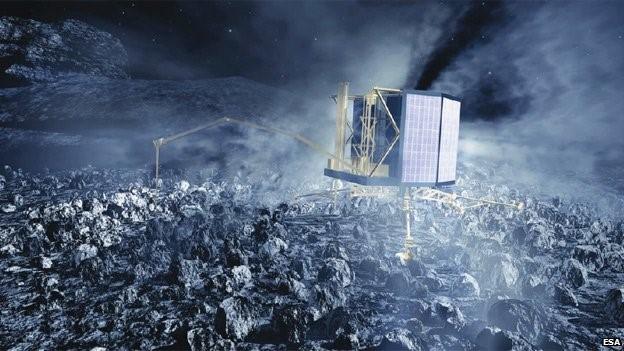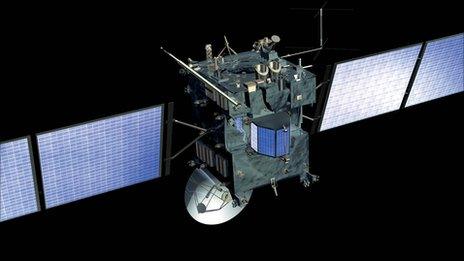Rosetta comet-chaser phones home
- Published
Delight in the control room as Rosetta sends back a signal confirming it is "awake"
Rosetta, Europe's comet-chasing spacecraft, has woken from its slumber.
A signal confirming its alert status was received by controllers in Darmstadt, Germany, at 18:17 GMT.
Rosetta has spent the past 31 months in hibernation to conserve power as it arced beyond the orbit of Jupiter on a path that should take it to Comet 67P/Churyumov-Gerasimenko in August.
Engineers will now finesse the probe's trajectory and prepare its instruments for the daring encounter.
One of the highlights of the mission will be the attempt to put a small robotic lander, Philae, on the surface of the 4.5km-wide comet. This will occur in November.
There were nail-biting moments in the Darmstadt control room as its flight engineers waited for the signal to come through. Three quarters of the way through the hour-long window of opportunity, they got what they were waiting for.
Gerhard Schwehm, mission manager for Rosetta, said: "After 31 months in hibernation, what is 45 minutes to wait?"
Andrea Accomazzo, the spacecraft operations manager, said: "I think it was the longest hour of my life, but also one of the most rewarding."
Monday's message, when it arrived, was a simple one - just a spike on the screens here at the European Space Agency's operations centre.
It was picked up in California by a 70m dish belonging to the US space agency, and then routed to Germany.
The signal contained no spacecraft telemetry, but its mere receipt from 800 million km away confirmed to controllers that Rosetta's automated systems were operating as expected.
In the coming hours and days, the Darmstadt team will talk to Rosetta to establish the full status of its systems.

It will be a slow process. The huge distance between the probe and Earth mean telecommands have a one-way travel time of 45 minutes.
Rosetta was put into hibernation in June 2011 because its trajectory through the Solar System was about to take it so far from the Sun that its solar panels would harvest minimal energy. The decision was therefore taken to put the spacecraft in a deep sleep.
Now that it is arcing back towards the Sun, more power is becoming available to operate the probe.
"From now until mid-March, we have planned virtually no activities on the spacecraft. We can afford to run only some basic check-outs," explained Andrea Accomazzo.
"But from mid-March to the end of April, we will be switching on the instruments one by one. We'll check them out and in a few cases even update their software."
From May, Rosetta will begin firing its thrusters to begin zeroing in on Comet 67P. Today, the separation is nine million km away. By mid-September, it will have been reduced to just 10km.
Launched back in 2004, Rosetta has taken a rather circuitous route out to its target.
This has involved making a number of flybys of the inner planets, using their gravity to pick up sufficient speed for the eventual encounter.
It has already delivered some fascinating science, particularly from the close passes it made to two asteroids - the rocks Steins, in 2008, and Lutetia, in 2010.
The plan is for Rosetta to escort the comet as it moves closer towards the Sun, monitoring the changes that take place on the body. The Philae lander will report changes that occur at the surface.

The simple signal tells the European Space Agency that the great endeavour remains on course
Comets - giant "dirty snowballs", as some have called them - are believed to contain materials that have remained largely unchanged since the formation of the Solar System 4.6bn years ago.
Rosetta's data should act therefore as a kind of time machine, to enable researchers to study how our local space environment has changed over time.
"We will sample the physical and chemical composition of the comet," said Matt Taylor, Esa's Rosetta project scientist.
"This will give us knowledge on how and where the comet was formed, and about its subsequent journey through the evolution of the Solar System.
"We can connect that as well to the formation of the planets themselves. And, in addition, the elemental make-up of the comet can be considered 'star stuff' - it will provide us knowledge of the formation processes within the Sun itself."
Rosetta is being billed as the big space event of 2014, and it is clear from the general and social media reaction to Monday's wake-up that interest in the mission is considerable.
"Science in general catches the public's imagination," said Thomas Reiter, Esa's director of human spaceflight and operations.
"In general, we try to find answers to fundamental questions, such as where do we come from, what will be our destiny and will we have to stick to this planet?
"The knowledge we get from missions like Rosetta - which is now moving into a very interesting stage - gets us closer to answering those types of questions."
Jonathan.Amos-INTERNET@bbc.co.uk and follow me on Twitter: @BBCAmos, external
- Published10 December 2013

- Published18 September 2013
- Published29 March 2012
- Published9 June 2011

- Published13 October 2010
- Published10 July 2010